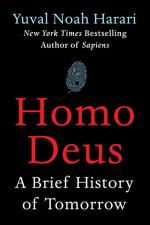|
This section contains 1,604 words (approx. 5 pages at 400 words per page) |

|
Summary
Chapter 2 traces the broad history of humanity and its relationship to other species on Earth. Harari notes that the current geological time period is known as the Anthropocene era, because it is dominated by humans. The world has very few wild animals species; many, particularly large mammals, were driven to extinction by the massive changes humans have caused in the Earth’s environment. Instead, the modern ecosystem is dominated by humans and their domesticated animals. Harari argues that our relationship to animals aligns with the evolution of religion. Most hunter-gatherers, he notes, were animists and thus considered themselves different but equal to other animal species. Following the agricultural revolution, however, humans began to see themselves as superior to the animals they controlled. This coincided with the emergence of theism. Though defined as the belief in superhuman gods, theism also centers humanity as the...
(read more from the Chapters 2 - 3 Summary)
|
This section contains 1,604 words (approx. 5 pages at 400 words per page) |

|




